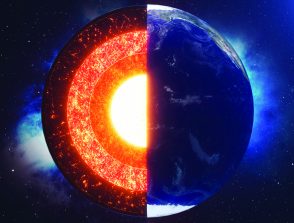Signature of inner core nucleation in the paleomagnetic record seen from geodynamo simulation
13/11/2025
IPGP - Îlot Cuvier
11:00
Séminaires Paléomagnétisme
Salle 310
Thomas Frasson
University of Leeds
Paleomagnetic data demonstrate that Earth's self-generated magnetic field has existed since at least 3.5 Ga, long before the inner core is thought to have nucleated between 500 Ma and 1.5 Ga. The inner core nucleation (ICN) is thought to have caused a drastic change in the operating conditions of the geodynamo, with an increase in the convective power, a change in the convective forcing in the core, and a change in the outer core's geometry. It has long been hypothesized that this event would be associated with a sudden increase in the virtual dipole moment in the paleomagnetic record because of the increased convective power. However, results from geodynamo simulations diverge regarding the variations in the dipole moment after ICN depending on the assumptions on the thermal evolution models and on the choice of simulation parameters.
We aim to better constrain the expected effect of ICN on the geodynamo. We take advantage of a large ensemble of thermal evolution scenarios to statistically predict the conditions in the Earth core before and after ICN, without relying on a specific scenario. We then run geodynamo simulations to study the behaviour of the magnetic dipole. We focus both on the strength of the dipole (dipole moment) and on the dispersion of magnetic poles that is constrain in the paleomagnetic record through the model G a parameter. Previous studies have overlooked the effect of changing from thermal to compositional convection after ICN, a change that is reflected in the Prandtl number (Pr) within the outer core. We study this effect by allowing Pr to increase after ICN in some of our simulations.
Our results show that, for a fixed Pr, ICN is associated with a smaller increase in the dipole moment than expected due to a change in the relative strength of the dipole compared to the internal magnetic field, confirming previous results. The change in dipole moment depends on the parameters of the geodynamo simulations, particularly on the strength of the Lorentz force within the core. We show that decreasing Pr before ICN to account for thermal convection increases the dipole moment relative to after ICN, a situation not well supported by paleomagnetic data. If Pr is decreased enough before ICN, we find that the dynamo ceases to operate in simulations, showing that the geodynamo could have been closer to extinction before ICN due to the thermal nature of convection. Magnetic poles dispersion decreases before ICN if the drop in convective power is very large. However, the effect of the Prandtl number on the dispersion is non-monotonic. These new results highlight the need for a better understanding of the effect of the Prandtl number in geodynamo simulations.






